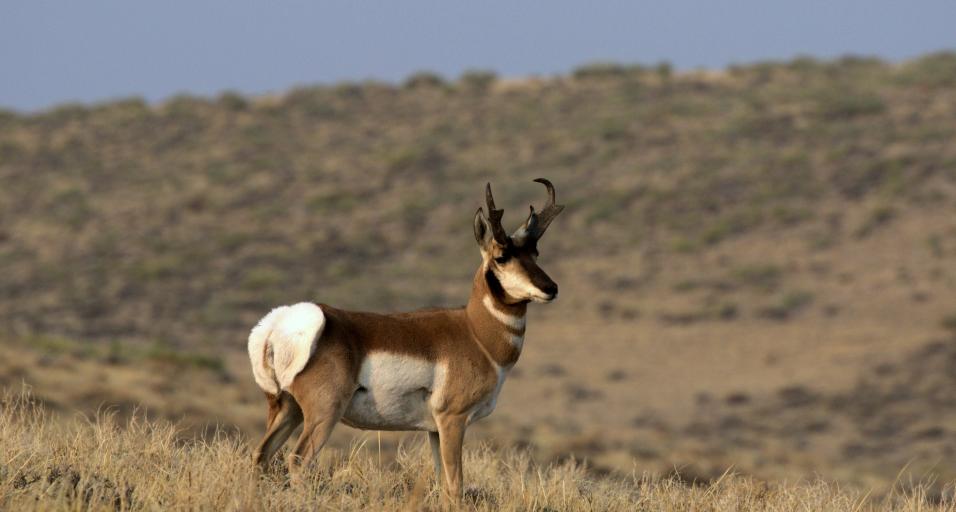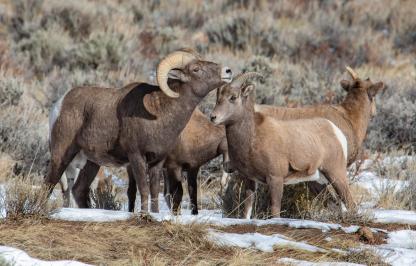Each year, wildlife biologists and game wardens conduct a variety of wildlife surveys to document as much information as possible about how big game populations are doing in each herd unit and within the hunt areas that make up each herd unit. Data collected include trend counts for elk and moose, and classification surveys for mule deer and pronghorn. Classification data is more detailed and include the number of females, juveniles, and males observed in each survey. It’s important to note that these surveys are not intended to count every animal in a population, nor is it possible to do so The sample sizes collected do, however, provide valuable data and assist field managers in developing population estimates and tracking population trends, ultimately lead to development of hunting season recommendations (in combination with harvest trends, habitat conditions, public comments and how the population sits with respect to management objectives).
Pronghorn
Pronghorn classification surveys are conducted just before the hunting season begins, in August and September each year. These are done by field personnel driving designated routes across each hunt area and all pronghorn groups are carefully observed to tally the number of does, fawns, yearling bucks, and adult bucks Then data from all hunt areas within a herd unit are combined to determine the age and sex composition of the herd. So, for the Beaver Rim pronghorn herd unit, there are seven hunt areas that have been tracked together since 1994 (Hunt Areas 65, 66, 67, 68, 69, 74, and 106).
Last fall, Game and Fish staff observed a 40% decline in the number of pronghorn along the same routes driven in 2019 (and for many years before that). Even though that is a pretty dramatic change, there are factors that can affect the number of animals seen. A bigger concern is that the ratio of fawns per 100 does was the lowest observed in 25 years. There was almost no rain across much of the Lander Region in 2020, with only 6/10ths of an inch of rain from Easter until Labor Day at the Lander Airport (about 88% below average). Combining such dry conditions after a pretty hard winter in 2019-20, pronghorn had a rough year. Survival of fawns born in 2019 was also lower than average, with the number of yearling bucks observed in fall 2020 being much lower than average. Several groups of pronghorn were observed in September with ribs and hip bones showing, indicating these animals were having a hard time finding good forage last summer. All this information points to a declining population, so it’s likely there will be very few doe/fawn licenses in the 2021 hunting season and fewer Type 1 licenses which are valid for any antelope, but for which most hunters harvest bucks.
Mule Deer
Mule deer classification surveys are flown with a helicopter in late fall/early winter, usually just after Thanksgiving. The South Wind River herd unit was surveyed over the last three days of November in 2020, and the Sweetwater herd unit was flown a week later in December. Unlike pronghorn, these surveys are conducted after hunting seasons and before bucks shed their antlers. The most recent surveys found a similar number of deer compared with the 2019 survey, despite a reduced flight budget and almost no snow cover in most areas. Fawn survival was about average, based on the number of fawns and ratio of fawns per 100 does. It was also much better in these herd units than was observed in pronghorn. This is probably the result of female mule deer having fawns in slightly wetter areas on average than pronghorn, which were more impacted by the dry conditions last spring and summer. Mule deer were also in much better body condition overall during the helicopter surveys. The mild winter so far has allowed all species to benefit from having access to forage on almost every acre of winter range (in mid-January during our elk and moose flights, some mule deer were observed at elevations well above traditional winter ranges in the Lander area, and several groups of mule deer were observed in several locations around Green Mountain and Crooks Mountain). The overall number of bucks and ratio of adult bucks per 100 does was a bit better than in 2019 as expected following conservative hunting season in 2020 intended to reduce harvest of mule deer bucks. However, there were fewer yearling bucks than hoped, indicating that mule deer fawns born in 2019 also suffered low survival in the 2019-20 winter. The data collected so far seems to indicate a fairly stable mule deer population in both herd units, but both herd units remain below objective. The conservative hunting seasons in 2020 were intended to be in place for at least two years, so the 2021 seasons will likely be the same.
White-tailed Deer
No formal surveys are conducted for white-tailed deer in the Lander or Jeffrey City area. However, white-tailed deer numbers seem to be growing in areas connected with agriculture and streams. No major expansion of white-tailed deer into traditional native mule deer habitats has been observed, although a few white-tailed deer have been observed and reported at higher elevations and into sagebrush/mountain shrub habitats and even onto the Shoshone National Forest near Frye Lake and Limestone Mountain areas. As such, hunting opportunities remain restricted mainly to private lands, with landowner access currently near maximum levels. So white-tailed deer seasons are not likely to change anytime soon.
Elk
As stated in the opening paragraph, elk surveys are conducted to track a mid-winter trend count. But we also collect age and sex composition data for nearly all elk groups observed. In the past several years, we have been able to use digital photography and video recordings to reduce the amount of time in the air needed to count and classify elk groups. This reduces disturbance of these elk and increases our safety and accuracy of data collected.
The Green Mountain elk trend count/classification survey was conducted on January 10, 2021. As with mule deer surveys in December, there was almost no new snow cover, plus the highest elevations were covered in low lying clouds and fog, making it impossible to fly there. At least one group of elk was missed on the west end of Green Mountain where tracks led into the timbered area that was obscured by fog/clouds. Based on these tracks, we believe there were between 100-150 elk in that group. We also were unable to fly the main part of Crooks Mountain on the south slopes where we often see several small groups of elk. In spite of the poor flying conditions and lack of snow cover forcing all elk out of the more heavily forested habitats, we observed 455 elk in hunt area 24, which is slightly below objective. But with the group of elk we know we didn’t find, as well as probably missing some other groups, the number of elk in the area is likely right at the average seen for over 10 years. We expect minimal change to the 2021 hunting seasons from last year. Harvest data will be received in mid-February and actual season recommendations will be drafted by mid-March.
The South Wind River elk herd unit contains hunt areas 25, 27, 28, and 99. The trend count/classification survey flights were completed on January 11th and 12th in areas 25, 27, and 28. Hunt area 99 is in the Pinedale Region and their personnel wll conduct their flights in February. Even without data from area 99, the trend count for the herd unit is the highest ever observed, mainly from a big increase in the number elk found in area 28. Area 25 had about the average number of elk (around 900) and area 27 had 200 elk, which is well above the average number since there is little snow cover to force those elk to lower areas. The high trend count is well above the management objective for the South Wind River elk herd.
Good numbers of bull elk were found in all hunt areas, and size quality seemed about average. Despite both herd units being above objective, we have heard increasing concerns from hunters and some landowners about hunter crowding and an apparent lack of elk in areas hunters expect to find them. Hunting opportunities have been fairly liberal and increases in license numbers and opportunity in the past have actually led to reduced harvest (or at least minimal increases), and more complaints from hunters about crowding, etc. Therefore, any changes to elk hunting seasons in 2021 will need to be carefully vetted with the public.
Moose
Moose trend count/classification surveys are conducted during elk survey flights, with extra time spent surveying moose habitats where elk are not often found. The flights done in January 2021 resulted in a lower number of moose observed than in the last few years. However, there were many areas with old and new tracks where moose could not be found, and given the general lack of snow cover, moose were greatly scattered in forested habitats away from willow riparian habitats. The count was similar to that observed in 2017, which was a similarly light snow year. In 2018 and 2019, with deeper snows, the counts those years were about 65% higher than in 2017, so we feel confident our population has not decreased as much as our trend count shows. Data since 2010 indicate the Lander moose herd (hunt areas 2 and 30) is a relatively stable population. The ratios of calves and bulls per 100 cow moose this year are among the best we’ve seen in this herd in the last 25 years. The hunting seasons have been conservative for the last several years, and we haven’t yet discussed whether any changes will be made for 2021.
Bighorn Sheep
No formal bighorn sheep surveys are conducted in the southern Wind River Mountains. However, there are several collared ewes that winter on the Wind River Reservation west of Ft. Washakie. Some of these ewes spend their summer months (and occasionally well into fall & winter) in the areas between Hobbs Peak and Lizard Head Peak. Groups of around 20 bighorn sheep have been reported from the Cathedral Peak area over the last several summers. Another small group of bighorn sheep remains in the North Fork Popo Agie Canyon.
How are the big game herds around Lander?
Stan Harter 307-332-2688



